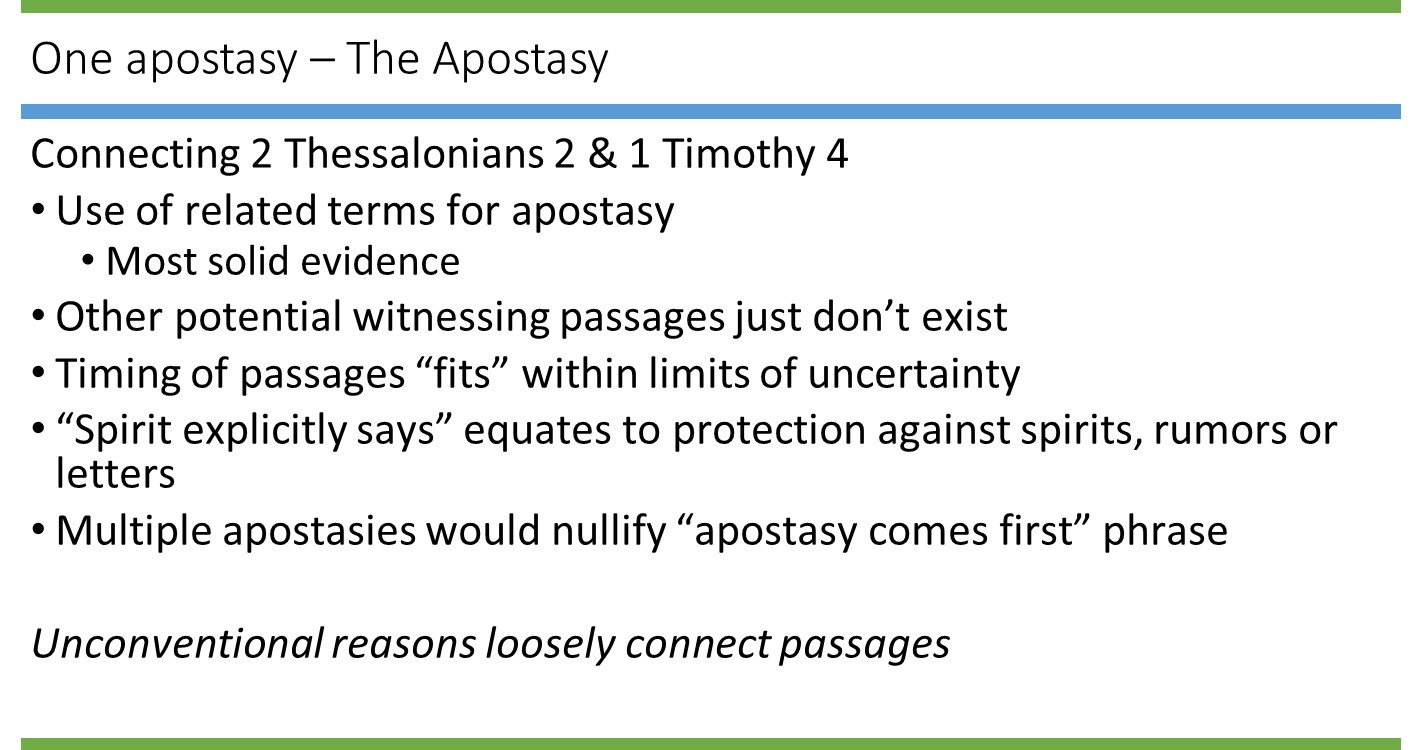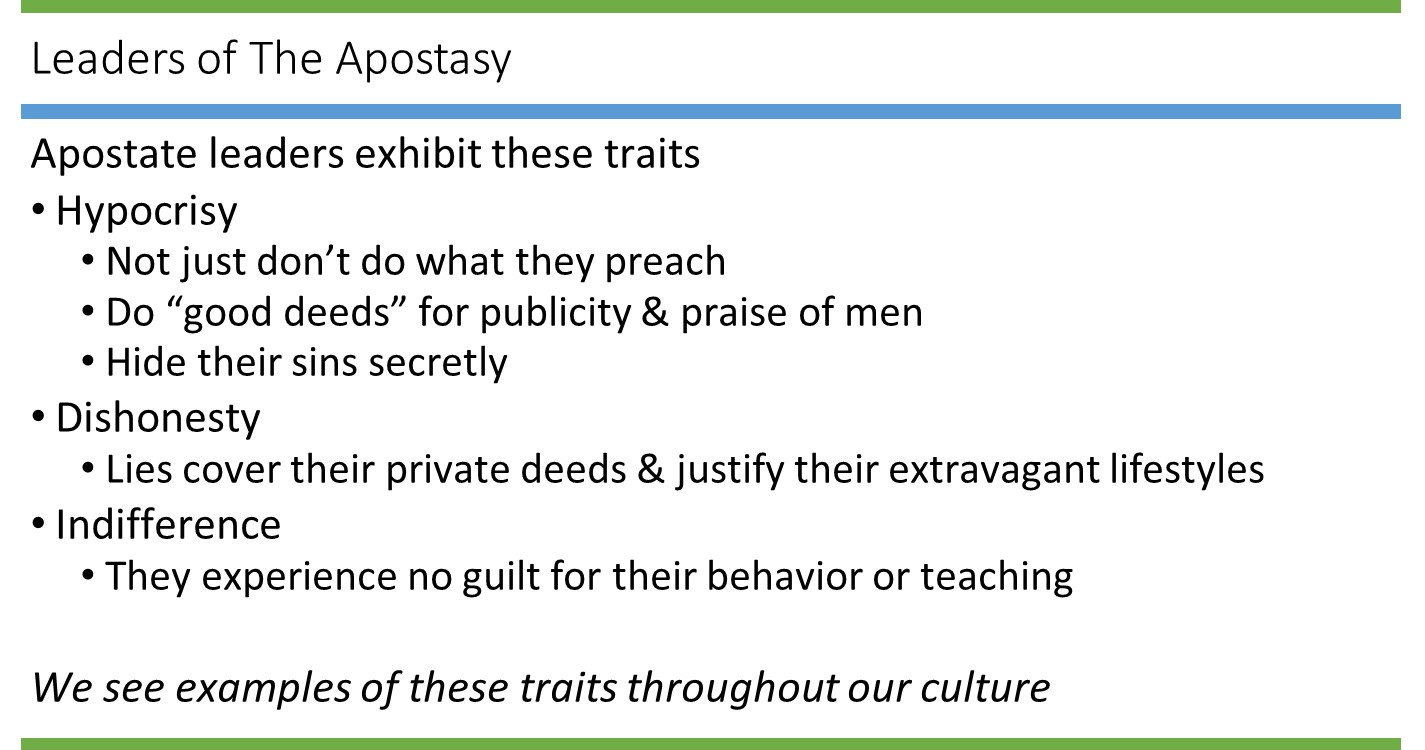[Continuing excerpts from chapter three of my new book - First Sign: beginning of the end- available on Amazon.com.
We learn about another sign of the end of the age. The Church will suffer a large withdrawal of people previously claiming the name of Christians. This happens all the time during this age, but the Apostasy will occur suddenly and in large numbers not seen in the past.]
Paul’s confirmation
Paul’s message in 2 Thessalonians 2 gives us a relative order of events but doesn’t define The Apostasy. We must look to his other writings for further elaboration. The strongest contender appears in 1 Timothy 4, which speaks of a future time of “apostasy.” The best connection between these passages comes from their usage of related terms. Paul uses the noun “apostasy” in 2 Thessalonians 2 (Strong’s # G646) and the verb form (“fall away”) in 1 Timothy 4 (Strong’s # G868). We can consider this significant since these words appear infrequently in the New Testament.
A few verses mean, frankly, that we don’t have that many alternative places to search for confirmation. I present most occurrences of these words in this chapter to assure you that I haven’t overlooked a refuting verse. Our need for a witness and lack of other options leaves 1 Timothy 4 by default. It contains one of the few verbs in the future tense which speaks of an event not expressly fulfilled elsewhere in the New Testament.
I freely admit to a relatively weak connection between these two passages (sounds like a “just so” argument). We generally have more to go on than just the use of similar words, but we should expect some limitations as we get into the weeds of prophetic study. I will offer several more reasons that help me feel more comfortable using these passages to confirm each other, but they don’t stand up as definitive proof. Therefore, one might take this part with a grain of salt. However, I make a better case in other ways.
Paul connects The Apostasy with The Day of the Lord in 2 Thessalonians 2. He connects the “falling away” of 1 Timothy 4 with “later times.” This term never appears anywhere else in the Bible. It could apply to all or most of the present age or it could apply to the end of the age. The uncertainty of this term aligns with the general uncertainty of events which begin at the end of the age. Naturally, we can’t predict these events until they occur. Moreover, it corresponds to the uncertainty we find in Thessalonians. It occurs “first” without telling us exactly when (relative to the second coming).
The phrase “the Spirit explicitly says” (1 Timothy 4) matches the intensity of Paul’s protection of 2 Thessalonians 2 (ignore spirits, messages and letters). Both passages come with additional assurance of authenticity.
Let’s consider an alternative. Let’s say that Paul reveals a distinct event to Timothy from what he predicts for the Thessalonians. Two apostasy events occur in Paul’s future. Now say that The Apostasy occurs; we can confirm it and every Christian agrees, “This is it!” Does it fulfill 2 Thessalonians 2 or 1 Timothy 4? Do you see my point? If two similar, but separate events occur without Paul telling us, then why bother? The fulfillment of an apostasy doesn’t prove anything, and Paul’s teaching has no power. If two apostasies occur, Paul must reveal both in a single passage to eliminate confusion. This hypothetical passage must include some indication of the difference between the two events. We see this sort of thing with resurrection. Christ speaks of two resurrections along with their differences in a single passage (John 5). This clears up the ambiguity and teaches something new.
Slide 41 One apostasy
Only a single apostasy event gives weight to Paul’s teaching to Thessalonica. That realization helps us confirm that both passages talk about the same event. This reasoning also helps us eliminate duplicates of most end-times events. Multiple world wars around the end of the age take away from the horror of Armageddon. Multiple returns of Jesus diminish His coming at the end of the age. We should expect just one of each of these events.
Times
With that introduction, let’s look at this new passage:
But the Spirit explicitly says that in later times some will fall away from the faith, paying attention to deceitful spirits and doctrines of demons, by means of the hypocrisy of liars seared in their own conscience as with a branding iron, men who forbid marriage and advocate abstaining from foods which God has created to be gratefully shared in by those who believe and know the truth. (1 Timothy 4:1-3)
This teaching stands in contrast to the qualifications for overseers and deacons Paul gives in 1 Timothy 3. The Church’s leaders have integrity and character. Paul labels the leaders of The Apostasy as hypocrites and liars without a conscience. He continues this stark contrast between the Church and the world in the rest of his letter to Timothy.
As we have seen already in the New Testament, apostasy often occurs in the present age. Professing believers make choices leading to their rejection of the Christian faith and Christ. Some return to Him (i.e. His disciples repented) and some remain in this state of treason and even betray true followers. Jesus connects apostasy with persecution as a natural part of the present age. How can we tell whether Paul predicts to Timothy a general description of the age or a specific incident near the end of the age?
As I mentioned before, Paul uses a term (later times) at the beginning verse which we never find anywhere else in the Bible. We cannot determine whether it applies to the present age (in general) or the time at the end of the age. Since Paul uses the future tense in his verbs, we can assume it occurs after his lifetime, but that still leaves our past, present, or future.
Sound Christian scholarship falls on both sides of this issue. Intellectuals view this passage as predictive of any one of several heretical offshoots of Christianity over the past two thousand years. To make these associations, they generalize the two doctrines presented by Paul – restricting marriage and diet – and apply them to any number of similar legalist prohibitions often found among cults. Other academics join me in viewing this passage as a prophetic revelation of a specific future event.
To remain consistent, I will strictly follow the teachings of Paul in this section. Thus, we will look for a coming event which precisely matches the details Paul reveals to Timothy. As we will see, this depends almost exclusively on the two doctrines concerning marriage and diet rather than on the leaders, followers or their alternative sources of inspiration.
Leaders
Paul describes the movement’s leaders using harsh and dramatic language. They sound very much like folks today who aggressively market themselves using mass media like a brand-name product rather than a real person.
Hypocrites do everything for show
Most people define a hypocrite as someone who says one thing while doing another. This only partially explains the behavior we see in the Bible.
Jesus describes the Pharisees and scribes in a long discourse near the end of His ministry (Matthew 23:1-36). He underscores their love of publicity. They crave the attention of others, places of honor, titles of respect and the pretense of long prayers. Yes, they perform virtuous deeds, but only so that others can witness their piety. Instead of giving privately, they call a press conference to announce their large gifts. Everything they do calls attention to themselves to ingratiate themselves with other people. Jesus confirms this analysis elsewhere (Matthew 6:1-6, 16-18; 7:1-5).
I recall a picture circulated during Easter season some years ago of a famous politician washing the feet of homeless people. While a nice gesture, this powerful person did this act on just one occasion and only for the sake of the photo. Another politician from the same party donated his time to the cause of homelessness for years without calling attention to his efforts. Without mentioning names or identifying political affiliations, the contrast between them demonstrates Jesus’ teaching of hypocrisy. Both do good works, but the hypocrite craves public attention in a show of humility rather than serving the needs of others in sincerity.
Lying to enable their lifestyles
Jesus compares the Pharisees to white-washed tombs – outwardly clean but filthy from secret sins – and accuses them of “devouring widows’ houses.” Their public persona (long prayers) differs greatly from their private deeds.
Slide 42 Leaders of apostasy
We can expect the leaders of The Apostasy to make a show of their piety. Lying to cover the lesser deeds of their lifestyles. They may project their own sins onto Christ and Christians (Matthew 5:11) to justify their teaching.
Without a conscience
Skin seared by extreme heat (like a branding iron) loses its ability to sense pressure, temperature and texture. Similarly, a seared conscience loses its ability to respond to the sensations of doing good and evil. Those with an active conscience react out of regret or guilt. The leaders of The Apostasy live free from these limitations. They cannot acknowledge their lies or hypocrisy. They sincerely believe that they represent goodness and virtue.






